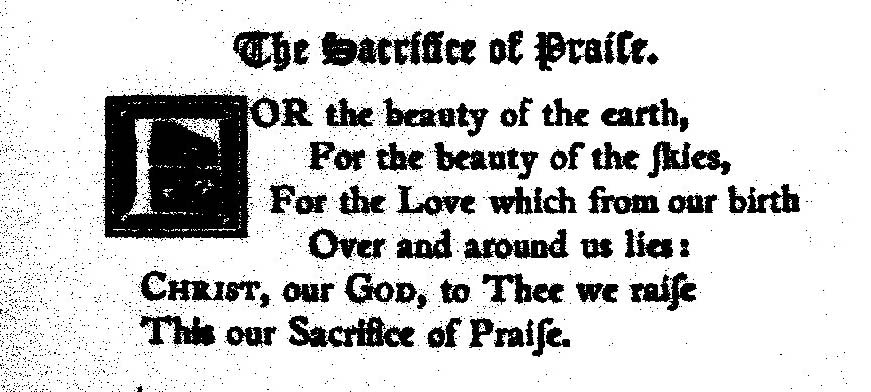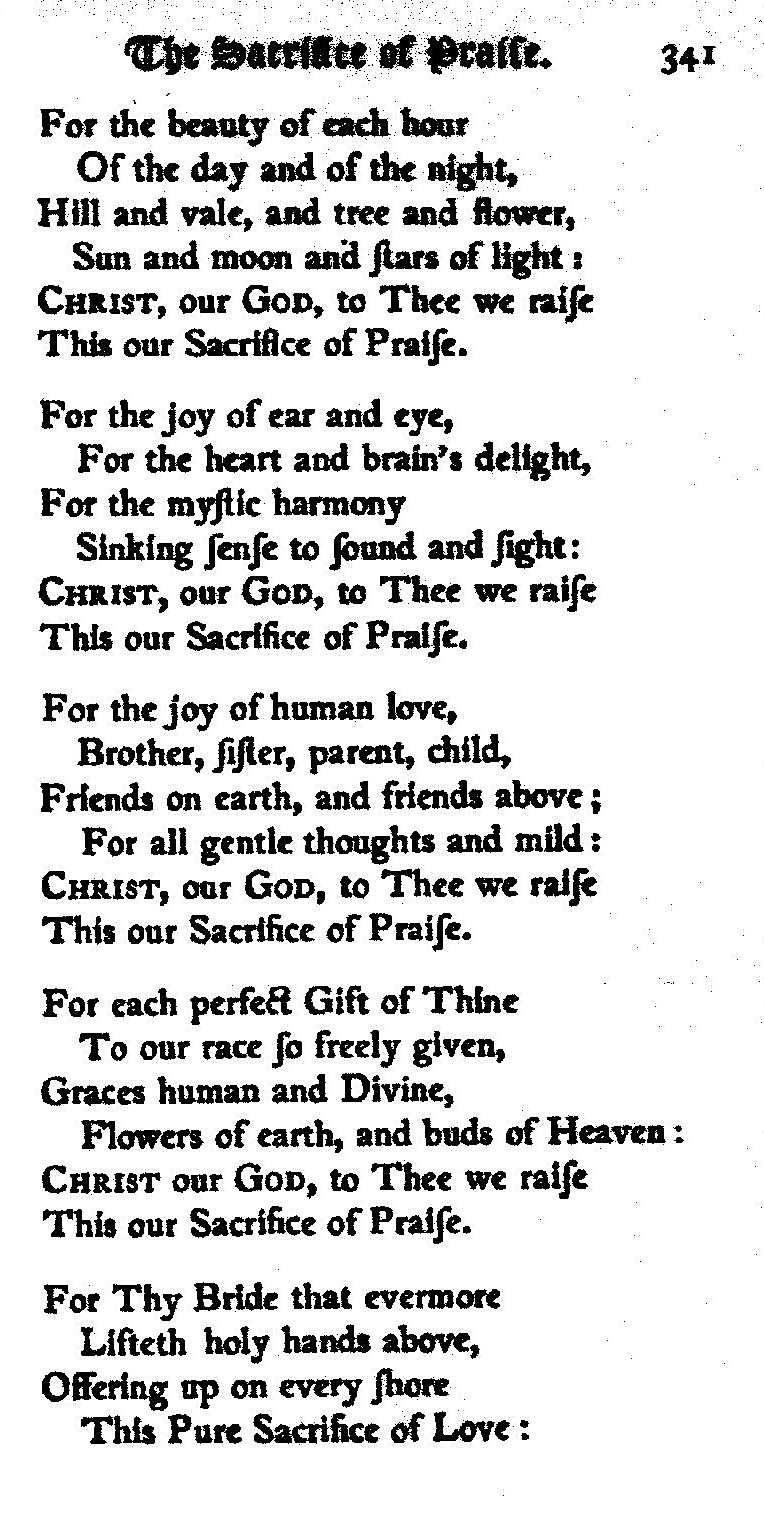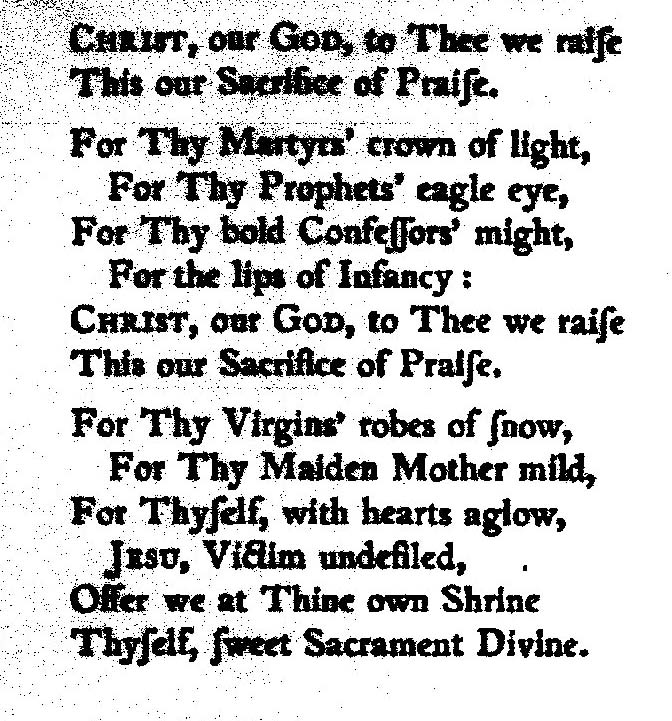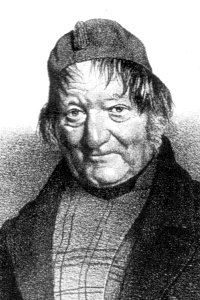| | 
‘For the Beauty of the Earth,’ one of the best loved hymns of the Thanksgiving season in the United States, had its origin in England. It is said that the hymn text was written by a scholarly young man in his thirtieth year, living in the city of Bath, England, who, resting on a hilltop, was inspired by the beauty of a spring morning in the surrounding countryside with its blooming violets and primroses, and returned home to write his feelings in verse. The text was originally written with eight verses, although only three or four are usually sung today. The first two verses have had great appeal for children with their elegantly simple descriptions of the earth, skies, and nature, and have been published in many children’s songbooks. In a sense, the hymn text parallels the scriptural account of human history in the Bible, beginning in the first verse with the earth and skies, describing the love which surrounded ‘our birth,’ which could refer to the love of God, and Adam and Eve and the birth of the human race, as well as our individual birth. The second verse continues with a description of the beauty of God’s creations, and these were experienced by our first parents. They enjoyed the sunlit day, the moonlit night, the hills, valleys, trees and flowers, as we continue to do in our time. Adam and Eve had children, and a family was formed where the love of parents and siblings was experienced and perpetuated to us, as described in the fourth verse. During his mortal ministry upon the earth, our Savior, Jesus Christ, demonstrated what it meant to be a friend. Gentleness and mildness were two of his defining characteristics. After He took upon himself the sins of the world, died on the cross and rose the third day, He ascended ‘above’, where He remains our greatest friend. His teachings tell us where those we love go when they die. The perfect human and divine gifts of grace spoken of in the fifth verse as given to our race (mankind) have been interpreted by some to mean the human birth of Jesus Christ, his love and divine atonement. However, there can be multiple meanings in the poetic imagery. The word ‘grace’ in theological terms means divine power and assistance from the Savior, Jesus Christ, to do that which we cannot do even through our best efforts, particularly, being cleansed from sin. ‘Graces,’ in the plural, can also be defined as ‘virtues coming from God.’ These virtues can be described as all high moral traits of righteousness that form character, such as faith, charity, courage, integrity, honesty, chastity, humility, and self-discipline, among others. The author may be suggesting that even at their best (full flower) among earthly men and women, these virtues are but the beginning of greater capacity in the hereafter (buds of heaven.) It is said that the hymn was originally written to be used for Anglican Communion services. The word ‘Anglican’ means ‘of England,’ and it is believed that the author was a member of the Church of England. It is noted, however, that the Church of England is one of a number of Anglican churches. The hymn’s original refrain, “Christ, our God, to Thee we raise This our Sacrifice of Praise,” was particularly worded to reflect the Anglican communion practice of offering a gift. It draws from a scriptural passage in Hebrews which follows a mention of the Jews’ practice of offering sacrifices, “By him therefore let us offer the sacrifice of praise to God continually, that is, the fruit of our lips giving thanks to his name.” It is believed the hymn was first published at London, England, with the title “The Sacrifice of Praise” in the 1864 second edition of ‘Lyra Eucharistica: Hymns and Verses on the Holy Communion, Ancient and Modern; with Other Poems,’ edited by The Reverend Orby Shipley. It is interesting to note that ‘Eucharist’ means communion and one origin of the word “Eucharist” derives from a Greek root meaning ‘grateful.’ It is also interesting to note that in the original 1864 publication shown in the photo below, the elongated script “S” called “long S” by printers, is evidence of period authenticity. It is said that the old-faced type style using the long S at the beginning and middle of some words was revived for a time in the mid-nineteenth century for its antiquarian effect. Standard use of this style that originated in fourth century Roman cursive script was discontinued in the late eighteenth century.



The most commonly sung verses of ‘For the Beauty of the Earth‘ are the first, second, fourth and fifth. These have universal Christian and poetic appeal. The refrain has been modified in several different ways over the years to suit the editors of various publications. By 1877, the ending “Sacrifice of Praise” had been replaced with “psalm of grateful praise,” or “hymn of grateful praise,” and “Lord of all” substituted for “Christ, our God,” in some hymnals. The text of the verses has also been modified in a number of hymnals, with ‘wonder’ and ‘glory’ substituted for ‘beauty,’ among other changes. In many hymnals the fifth verse has been almost completely rewritten. There are so many variations no one should be surprised if the hymn they know and love is a little different than the next denomination’s version. “For the Beauty of the Earth” in its many variations is known to have been published in over 450 hymnals of different denominations. Its first appearance in a hymnal of The Church of Jesus Christ of Latter-day Saints (LDS) was in the 1985 edition. The first two verses of the hymn had previously been included in the children’s songbooks prior to the 1989 edition. The hymn as it appears in the 1985 LDS Hymnal has a few differences from the previous version in the 1969 LDS children’s songbook ‘Sing With Me.’ The text of the original fourth verse was added to make three verses total; two notes were deleted from the music, the word ‘wonder’ in the second verse was changed back to the original ‘beauty’ and the word ‘flower’ was contracted to ‘flow’r.’ The hymn tune most commonly paired with the text of For the Beauty of the Earth is known today as DIX. It originated as an 1838 chorale melody by Conrad Kocher for “Treuer Heiland, wir sind hir,” (Faithful Savior, We are Here) found in his collection “Stimmen aus den Reiche Gottes” (Voices from the Kingdom of God). The tune was edited by the London, England, church musician and music editor William H. Monk, who shortened the refrain by two measures, and it was published with a Christmas text by William C. Dix in 1861. This is said to have been the first use of the tune with an English text. The resulting hymn, ‘As with Gladness,’ became widely used and the tune was named DIX as a result. The combination of text and tune has created a wonderful lasting work of devotional expression.
| | 
Folliott Sandford (or Sanford) Pierpoint was born the son of William Horne Pierpoint and his second wife, Annabella, about 1835 at, or near, Bath, England. Some sources say his birthplace was Spa Villa, a detached property on Bathwick Hill. He is believed to be the youngest of four boys and one girl in the family. Bath is located on the River Avon in southwest England. The town and its name originate from the hot mineral springs which from Roman times were utilized for bathing and healing. At the turn of the 18th century, visits to the baths by the royal family and the efforts of Beau Nash helped Bath become a fashionable place of social elegance and a place for diversion and amusement as well as health. Bath’s popularity as a spa resort for the rich was at its peak at the time of Folliott Pierpont’s birth. Folliott’s father, William, was active in the community, serving as a district and city commissioner and on several committees. His mother, Annabella, was active in the Bath Ladies’ Branch Bible Society. As a child Folliott likely attended the Bath Grammar School as his older brother did. As a young man he traveled 160 miles northeast and entered Queen’s College, Cambridge University, graduating in 1857 and/or 1871. It is said that he pursued classical studies. The initials M.A. are seen as a suffix to his name in some records so it is presumed that he received a Master of Arts degree at the later date. Queens’ College was founded in 1448 by Margaret of Anjou, wife of King Henry VI, and sits astride the River Cam on the southern side of the campus in the town of Cambridge. One of thirty-one self-governing colleges in the university, it continues to be a thriving academic community today. It is said that Folliott taught classics for a time at Somersetshire College. This is likely the same college in Bath where his chess-playing older brother, Edward, taught mathematics around 1863. The building still stands, however the college may have later moved, or been discontinued. It is believed that Folliott followed the example of at least two of his brothers in entering the clergy of the Church of England, and is said to have lived for a time in neighboring Devonshire to the southwest and Monmouthshire to the northwest, as they were then defined. His ecclesiastical duties could be assumed to have been sympathetic to his interest in poetry. He produced a volume of poetry that was republished in 1878 with the title ‘Songs of Love, the Chalice of Nature, and Lyra Jesu.’ He also contributed hymns to the ‘Churchman’s Companion’ and ‘Lyra Eucharistica.’ The latter including his text of ‘For the Beauty of the Earth.’ Folliott Pierpoint concluded his studious life of 82 years in March of 1917 at Newport, Monmouthshire, Wales.
For the Beauty of the Earth - 1985 LDS Hymnal Text: For the beauty of the earth, For the beauty of the skies, For the love which from our birth Over and around us lies, Lord of all, to thee we raise This our hymn of grateful praise. For the beauty of each hour Of the day and of the night, Hill and vale, and tree and flow’r, Sun and moon, and stars of light, Lord of all, to thee we raise This our hymn of grateful praise. For the joy of human love, Brother, sister, parent, child, Friends on earth, and friends above, For all gentle thoughts and mild, Lord of all, to thee we raise This our hymn of grateful praise.
| |

Conrad Kocher was born in December of 1786 at Ditzingen, Württemberg, Germany. Di(e)tzingen is located in southwestern Germany about ten miles northwest of Stuttgart. It is said that Conrad was trained as a teacher and at the age of seventeen traveled about 1500 miles northeast to St. Petersburg, Russia, to work as a tutor. He had a love for music, however, particularly the works of Haydn and Mozart. It is believed that he studied piano and composition while working in Russia and returned to Germany eight years later, about 1811, to pursue a career in music. His return was likely influenced by the expectation of Napoleon’s 1812 invasion of Russia. Conrad settled in Stuttgart and some of his early compositions were published by the notable Cotta publishing firm, which sent him to study music in Italy for a time. It is said that while there he may have been influenced by the works of Palestrina. In 1821 he founded the School for Sacred Song in Stuttgart, which was influential in bringing four-part singing to the churches of the region. For thirty-eight years (1827 to 1865) Conrad Kocher served as organist and choir director at the Striftsckirche in Stuttgart. He was also active as a writer and an editor, publishing a treatise on church music, and a collection of chorales in addition to his compositional work, which included sonatas, two operas and an oratorio. It is said that in 1852 he received an honorary Doctor of Philosophy from the University of Tübingen, one of Europe’s oldest universities, founded in 1477 at Tübingen, about forty miles southwest of Stuttgart. Conrad Kocher concluded his remarkable life at the age of 86, in March of 1872, at Stuttgart, Germany.
|